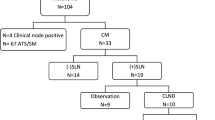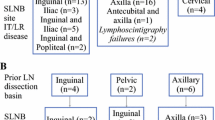Abstract
Background
The rarity of melanoma in young patients, particularly pediatric ones, has to date precluded any valid comparisons being made between young patients and adults undergoing sentinel lymph node biopsy (SLNB) for intermediate thickness localized melanoma. The present study takes advantage of the large Sydney Melanoma Unit (SMU) database to clarify this issue.
Materials and Methods
Clinical and pathologic data on pediatric and adolescent AJCC Stage I and II cutaneous melanoma patients aged <20 years undergoing SLNB at the SMU between January 1993 and February 2008 were reviewed. SLNB positivity rates and outcomes in these patients were compared with adult SMU patients.
Results
In 55 young patients, overall median tumor thickness was 1.7 mm (range, 0.6–5.2 mm) and overall SLNB positivity rate was 14 of 55 (25%), tumors tending to be thicker (median, 2.6 mm), and SLNB positivity rate higher (2 of 6; 33%) in patients aged <10 years. Of the 14 patients, 13 underwent immediate completion lymph node dissection (CLND); 2 patients had non-SLN metastases (15.4%). Only 0.7% of a total of 295 lymph nodes removed at CLND were involved with melanoma. In 14 SLNB-positive patients with follow-up data, 3 (21%) have died from melanoma after a median follow-up of 60 months, compared with 42% of 356 SLNB positive adults.
Conclusions
Although the SLNB positivity rate was higher in pediatric and adolescent melanoma patients than in adults (25% vs. 17%, respectively), non-SLN positivity and melanoma-specific death rates were low.

Similar content being viewed by others
References
Conti EM, Cercato MC, Gatta G, Ramazzotti V, Roscioni S, EUROCARE Working Group. Childhood melanoma in Europe since 1978: a population-based survival study. Eur J Cancer. 2001;37:780–4.
Downard CD, Rapkin LB, Gow KW. Melanoma in children and adolescents. Surg Oncol. 2007;16:215–20.
Hamre MR, Chuba P, Bakhshi S, Thomas R, Severson RK. Cutaneous melanoma in childhood and adolescence. Pediatr Hematol Oncol. 2002;19:309–17.
Lange JR, Palis BE, Chang DC, Soong SJ, Balch CM. Melanoma in children and teenagers: an analysis of patients from the National Cancer Data Base. J Clin Oncol. 2007;25:1363–8.
Pappo AS. Melanoma in children and adolescents. Eur J Cancer. 2003;39:2651–61.
Strouse JJ, Fears TR, Tucker MA, Wayne AS. Pediatric melanoma: risk factor and survival analysis of the surveillance, epidemiology and end results database. J Clin Oncol. 2005;23:4735–41.
Balch CM, Soong SJ, Gershenwald JE, Thompson JF, Reintgen DS, Cascinelli N, et al. Prognostic factors analysis of 17,600 melanoma patients: validation of the American Joint Committee on Cancer melanoma staging system. J Clin Oncol. 2001;19:3622–34.
Morton DL, Cochran AJ, Thompson JF, Elashoff R, Essner R, Glass EC, et al. Sentinel node biopsy for early-stage melanoma: accuracy and morbidity in MSLT-I, an international multicenter trial. Ann Surg. 2005;242:302–11 (discussion 311–3).
Morton DL, Thompson JF, Cochran AJ, Mozzillo N, Elashoff R, Essner R, et al. Sentinel-node biopsy or nodal observation in melanoma. N Engl J Med. 2006;355:1307–17.
Caraco C, Marone U, Botti G, Celentano E, Lastoria S, Mozzillo N. Age as predictor in patients with cutaneous melanoma submitted to sentinel lymph node biopsy. Eur J Surg Oncol. 2006;32:970–3.
Statius Muller MG, van Leeuwen PA, de Lange-De Klerk ES, van Diest PJ, Pijpers R, Ferwerda CC, et al. The sentinel lymph node status is an important factor for predicting clinical outcome in patients with Stage I or II cutaneous melanoma. Cancer. 2001;91:2401–8.
Ferrari A, Bono A, Baldi M, Collini P, Casanova M, Pennacchioli E, et al. Does melanoma behave differently in younger children than in adults? A retrospective study of 33 cases of childhood melanoma from a single institution. Pediatrics. 2005;115:649–54.
Livestro DP, Kaine EM, Michaelson JS, Mihm MC, Haluska FG, Muzikansky A, et al. Melanoma in the young: differences and similarities with adult melanoma: a case-matched controlled analysis. Cancer. 2007;110:614–24.
Roaten JB, Partrick DA, Pearlman N, Gonzalez RJ, Gonzalez R, McCarter MD. Sentinel lymph node biopsy for melanoma and other melanocytic tumors in adolescents. J Pediatr Surg. 2005;40:232–5.
Kogut KA, Fleming M, Pappo AS, Schropp KP. Sentinel lymph node biopsy for melanoma in young children. J Pediatr Surg. 2000;35:965–6.
Neville HL, Andrassy RJ, Lally KP, Corpron C, Ross MI. Lymphatic mapping with sentinel node biopsy in pediatric patients. J Pediatr Surg. 2000;35:961–4.
Toro J, Ranieri JM, Havlik RJ, Coleman JJ III, Wagner JD. Sentinel lymph node biopsy in children and adolescents with malignant melanoma. J Pediatr Surg. 2003;38:1063–5.
Thompson JF. Operative technique for sentinel lymphadenectomy: blue dye identification and use of a gamma probe. In: Nieweg OE, Essner R, Reintgen D, Thompson JF, editors. Lymphatic mapping and probe applications in oncology. New York: Marcel Dekker; 2000. p. 71–86.
Thompson JF, Niewind P, Uren RF, Bosch CM, Howman-Giles R, Vrouenraets BC. Single-dose isotope injection for both preoperative lymphoscintigraphy and intraoperative sentinel lymph node identification in melanoma patients. Melanoma Res. 1997;7:500–6.
Thompson JF, Shaw HM. Sentinel node mapping for melanoma: results of trials and current applications. Surg Oncol Clin N Am. 2007;16:35–54.
Uren RF, Howman-Giles R, Thompson JF, Shaw HM, Quinn MJ, O’Brien CJ, et al. Lymphoscintigraphy to identify sentinel lymph nodes in patients with melanoma. Melanoma Res. 1994;4:395–9.
Uren RF, Howman-Giles RB, Shaw HM, Thompson JF, McCarthy WH. Lymphoscintigraphy in high-risk melanoma of the trunk: predicting draining node groups, defining lymphatic channels and locating the sentinel node. J Nucl Med. 1993;34:1435–40.
Li LX, Scolyer RA, Ka VS, McKinnon JG, Shaw HM, McCarthy SW, et al. Pathologic review of negative sentinel lymph nodes in melanoma patients with regional recurrence: a clinicopathologic study of 1152 patients undergoing sentinel lymph node biopsy. Am J Surg Pathol. 2003;27:1197–202.
Scolyer RA, McCarthy SW, Elder DE. Frontiers in melanocytic pathology. Pathology. 2004;36:385–6.
Scolyer RA, Murali R, McCarthy SW, Thompson JF. Pathologic examination of sentinel lymph nodes from melanoma patients. Semin Diagn Pathol. 2008;25:100–11.
Thompson JF, Shaw HM. The surgical management of cutaneous melanoma: have we made any real progress in 100 years? Cancer Forum. 2006;30:103–6.
(AACR) AIoHaWAAAoCR. Cancer in Australia 2001. Vol. AIHW cat. no. CAN 23. Canberra: Australian Institute of Health and Welfare; 2004.
Shaw HM, Thompson JF. Cutaneous melanoma in childhood: incidence and prognosis. In: Thompson JF, Morton DL, Kroon BB, editors. Textbook of melanoma. London: Martin Dunitz; 2004. p. 379–86.
Sassen S, Shaw HM, Colman MH, Scolyer RA, Thompson JF. The complex relationships between sentinel node positivity, patient age, and primary tumor desmoplasia: analysis of 2303 melanoma patients treated at a single center. Ann Surg Oncol. 2008;15:630–7.
Gibbs P, Moore A, Robinson W, Walsh P, Golitz L, Gonzalez R. Pediatric melanoma: are recent advances in the management of adult melanoma relevant to the pediatric population. J Pediatr Hematol Oncol. 2000;22:428–32.
Chao C, Martin RC II, Ross MI, Reintgen DS, Edwards MJ, Noyes RD, et al. Correlation between prognostic factors and increasing age in melanoma. Ann Surg Oncol. 2004;11:259–64.
Sondak VK, Taylor JM, Sabel MS, Wang Y, Lowe L, Grover AC, et al. Mitotic rate and younger age are predictors of sentinel lymph node positivity: lessons learned from the generation of a probabilistic model. Ann Surg Oncol. 2004;11:247–58.
Pacella SJ, Lowe L, Bradford C, Marcus BC, Johnson T, Rees R. The utility of sentinel lymph node biopsy in head and neck melanoma in the pediatric population. Plast Reconstr Surg. 2003;112:1257–65.
Shah NC, Gerstle JT, Stuart M, Winter C, Pappo A. Use of sentinel lymph node biopsy and high-dose interferon in pediatric patients with high-risk melanoma: the Hospital for Sick Children experience. J Pediatr Hematol Oncol. 2006;28:496–500.
Topar G, Zelger B. Assessment of value of the sentinel lymph node biopsy in melanoma in children and adolescents and applicability of subcutaneous infusion anesthesia. J Pediatr Surg. 2007;42:1716–20.
Pan WR, Suami H, Taylor GI. Senile changes in human lymph nodes. Lymphat Res Biol. 2008;6:77–83.
Crotty KA, Scolyer RA, Li L, Palmer AA, Wang L, McCarthy SW. Spitz naevus versus Spitzoid melanoma: when and how can they be distinguished? Pathology. 2002;34:6–12.
Dahlstrom JE, Scolyer RA, Thompson JF, Jain S. Spitz naevus: diagnostic problems and their management implications. Pathology. 2004; 36:452–7.
McCarthy SW, Scolyer RA. Melanocytic lesions of the face: diagnostic pitfalls. Ann Acad Med Singap. 2004;33:3–14.
Scolyer R, Thompson J, Stretch JR, McCarthy SW. Collaboration between clinicians and pathologists: a necessity for the optimal management of melanoma patients. Cancer Forum. 2005;29:76–81.
Elder DE, Xu X. The approach to the patient with a difficult melanocytic lesion. Pathology. 2004;36:428–34.
Barnhill RL, Argenyi ZB, From L, Glass LF, Maize JC, Mihm MC Jr, et al. Atypical Spitz nevi/tumors: lack of consensus for diagnosis, discrimination from melanoma, and prediction of outcome. Hum Pathol. 1999;30:513–20.
Cerroni L, Kerl H. Tutorial on melanocytic lesions. Am J Dermatopathol. 2001;23:237–41.
Mones JM, Ackerman AB. “Atypical” Spitz’s nevus, “malignant” Spitz’s nevus, and “metastasizing” Spitz’s nevus: a critique in historical perspective of three concepts flawed fatally. Am J Dermatopathol. 2004;26:310–33.
Spatz A, Barnhill RL. The Spitz tumor 50 years later: revisiting a landmark contribution and unresolved controversy. J Am Acad Dermatol. 1999;40:223–8.
Gamblin TC, Edington H, Kirkwood JM, Rao UN. Sentinel lymph node biopsy for atypical melanocytic lesions with spitzoid features. Ann Surg Oncol. 2006;13:1664–70.
Lohmann CM, Coit DG, Brady MS, Berwick M, Busam KJ. Sentinel lymph node biopsy in patients with diagnostically controversial spitzoid melanocytic tumors. Am J Surg Pathol. 2002;26:47–55.
Murakami M, Wada T, Kashiwagi T, Ishida-Yamamoto A, Iizuka H. Nodular malignant melanoma with Spitz nevus-like pathological features finally confirmed by the pathological feature of the sentinel lymph node. J Dermatol. 2007;34:821–8.
Murali R, Sharma RN, Thompson JF, Stretch JR, Lee CS, McCarthy SW, et al. Sentinel lymph node biopsy in histologically ambiguous melanocytic tumors with spitzoid features (so-called atypical spitzoid tumors). Ann Surg Oncol. 2008;15:302–9.
Urso C, Borgognoni L, Saieva C, Ferrara G, Tinacci G, Begliomini B, et al. Sentinel lymph node biopsy in patients with “atypical Spitz tumors.” A report on 12 cases. Hum Pathol. 2006;37:816–23.
Zuckerman R, Maier JP, Guiney WB Jr, Huntsman WT, Mooney EK. Pediatric melanoma: confirming the diagnosis with sentinel node biopsy. Ann Plast Surg. 2001;46:394–9.
Rodriguez HA, Ackerman LV. Cellular blue nevus. Clinicopathologic study of forty-five cases. Cancer. 1968;21:393–405.
Smith KJ, Barrett TL, Skelton HG III, Morgan AM, Barrett TL, Lupton GP. Spindle cell and epithelioid cell nevi with atypia and metastasis (malignant Spitz nevus). Am J Surg Pathol. 1989;13:931–9.
Carlson GW. Age and the incidence of sentinel lymph node metastases in melanoma. Ann Surg Oncol. 2004;11:236–7.
Author information
Authors and Affiliations
Corresponding author
Rights and permissions
About this article
Cite this article
Howman-Giles, R., Shaw, H.M., Scolyer, R.A. et al. Sentinel Lymph Node Biopsy in Pediatric and Adolescent Cutaneous Melanoma Patients. Ann Surg Oncol 17, 138–143 (2010). https://doi.org/10.1245/s10434-009-0657-4
Received:
Revised:
Accepted:
Published:
Issue Date:
DOI: https://doi.org/10.1245/s10434-009-0657-4




